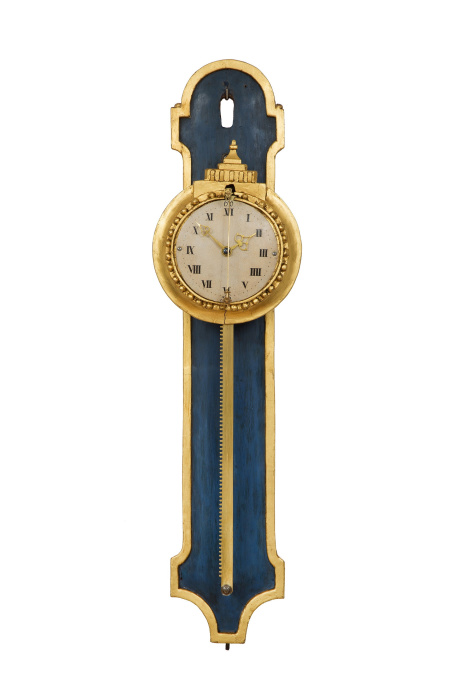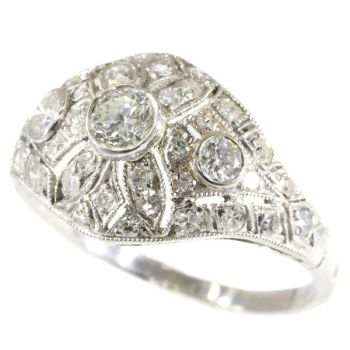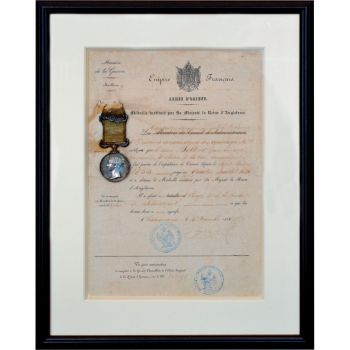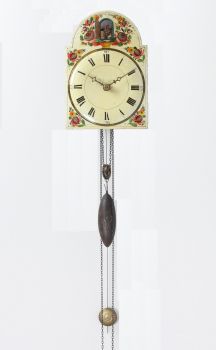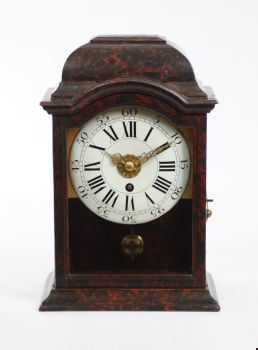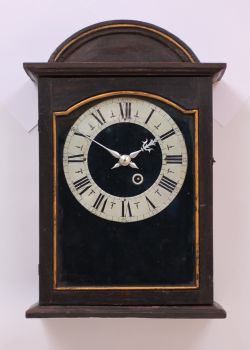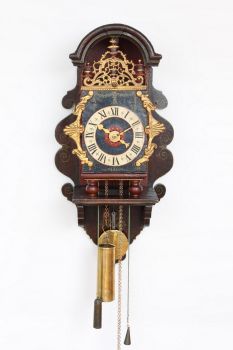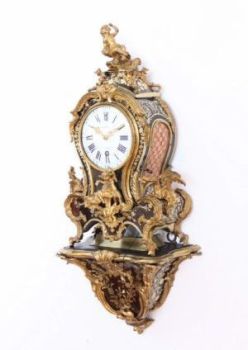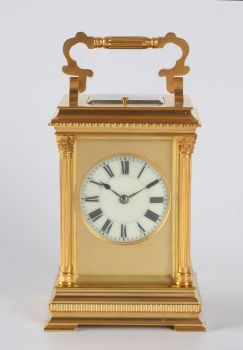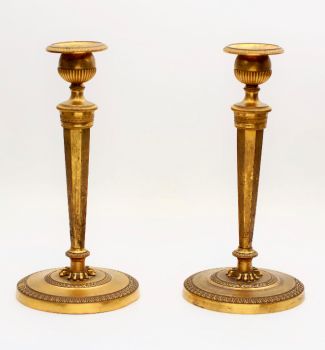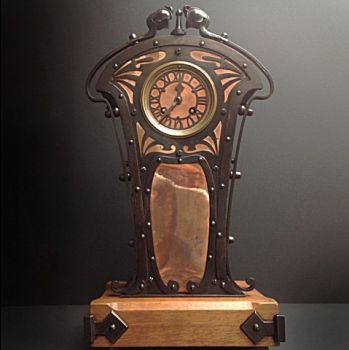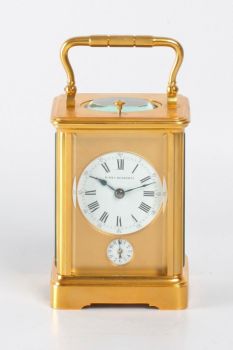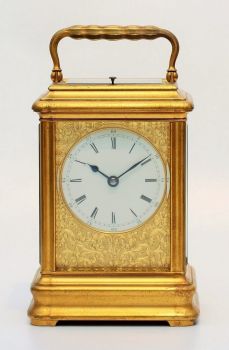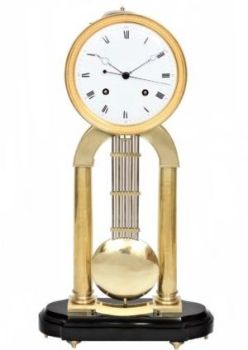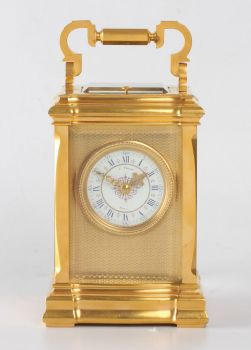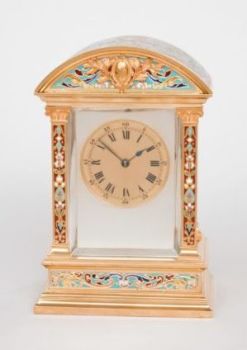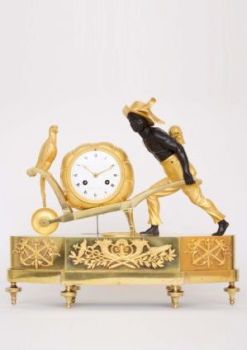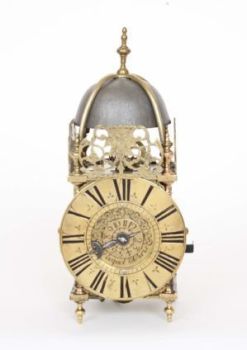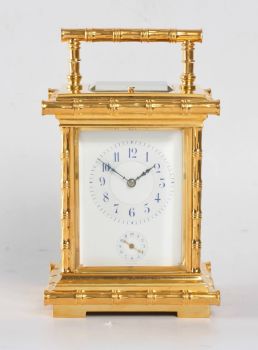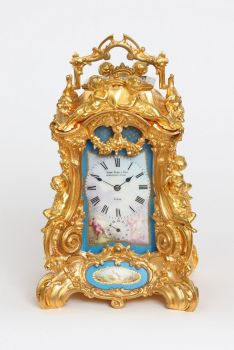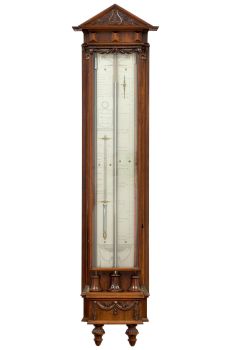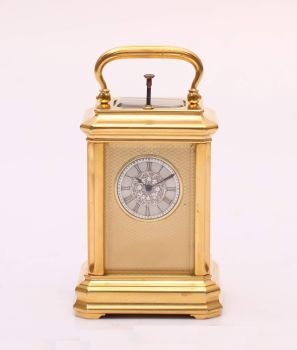A South German Louis XVI polychrome and parcel gilt rack wall timepiece, circa 1780 1780
Artiste Inconnu
63.50 ⨯ 12 ⨯ 11 cm
€ 16.000
Gude & Meis Antique clocks and Music Boxes
- Sur l'oeuvre d'art10.7-cm painted dial with Roman numerals and pierced brass hands, 30-hour movement with verge escapement and front pendulum, driven by its own weight along the rack, parcel gilt bezel and cresting, shaped polychrome and parcel gilt back board.
Most clocks have a movement that has an energy source like a mainspring or a weight to drive the clock. Besides that the movement needs a regulating part that makes sure that the energy is released regularly. Without it the hands would spin around uncontrollably until the spring would have wound down or the weight reaches the floor. The amusing part this clock is that the movement and dial are used as a weight itself. By engaging with the teeth on the ‘rack’ the wheels of the movement can turn. One can simply ‘wind’ the clock by pushing the whole back up the rack. Another amusing part of this clock is the front pendulum. This South German and Alpine tradition is called ‘Kuhschwanz Pendel’ which translates into ‘Cow tail pendulum’. This is not surprising because the pendulum swing like the tail of a cow in front of the dial. Many people are fascinated by the movement slowly descending down the rack while running. A beautiful object that will be a conversation piece for anyone who sees it for the first time. - Sur l'artiste
Il peut arriver qu'un artiste ou un créateur soit inconnu.
Certaines œuvres ne doivent pas être déterminées par qui elles sont faites ou elles sont faites par (un groupe d') artisans. Les exemples sont des statues de l'Antiquité, des meubles, des miroirs ou des signatures qui ne sont pas claires ou lisibles, mais aussi certaines œuvres ne sont pas signées du tout.
Vous pouvez également trouver la description suivante :
•"Attribué à …." A leur avis probablement une oeuvre de l'artiste, au moins en partie
•« Atelier de …. ou « Atelier de » À leur avis, une œuvre exécutée dans l'atelier ou l'atelier de l'artiste, éventuellement sous sa direction
•« Cercle de… ». A leur avis une oeuvre de la période de l'artiste témoignant de son influence, étroitement associée à l'artiste mais pas forcément son élève
•« Style de … ». ou "Suiveur de ...." Selon eux, une œuvre exécutée dans le style de l'artiste mais pas nécessairement par un élève ; peut être contemporain ou presque contemporain
•« Manière de… ». A leur avis une oeuvre dans le style de l'artiste mais d'une date plus tardive
•"Après …." A leur avis une copie (quelle qu'en soit la date) d'une oeuvre de l'artiste
•« Signé… », « Daté… ». ou « Inscrit » À leur avis, l'œuvre a été signée/datée/inscrite par l'artiste. L'ajout d'un point d'interrogation indique un élément de doute
• "Avec signature ….", "Avec date ….", "Avec inscription …." ou "Porte signature/date/inscription" à leur avis la signature/date/inscription a été ajoutée par quelqu'un d'autre que l'artiste
Êtes-vous intéressé par l'achat de cette oeuvre?
Artwork details
Related artworks
- 1 - 4 / 12
Artiste Inconnu
Een Gotische zuidelijke Nederlanden wandklok1580 - 1590
Prix sur demandeNico van den Assem restauratie
1 - 4 / 24- 1 - 4 / 12

